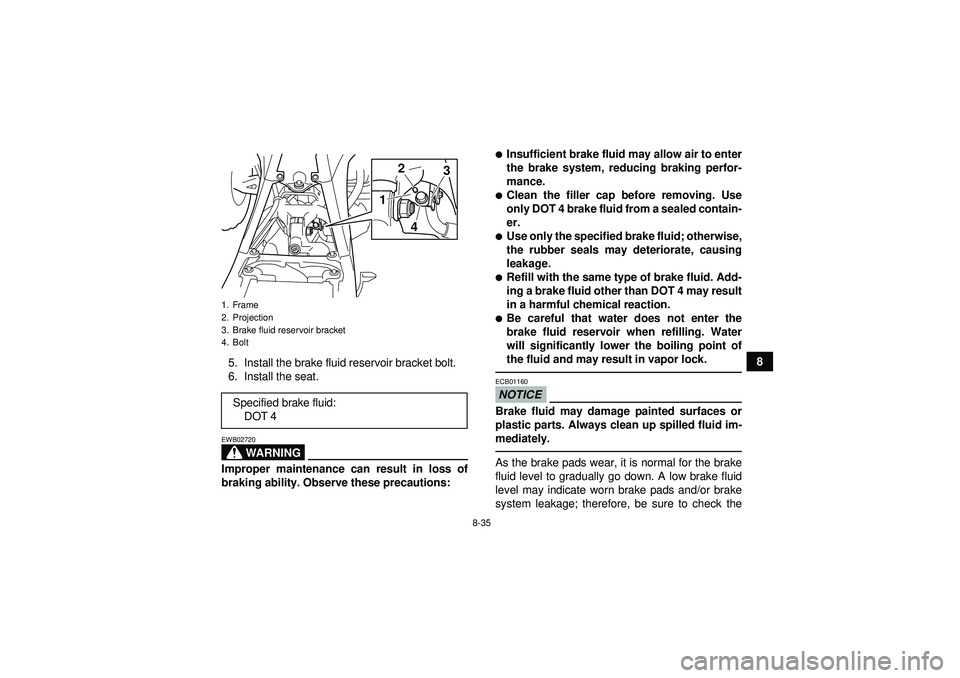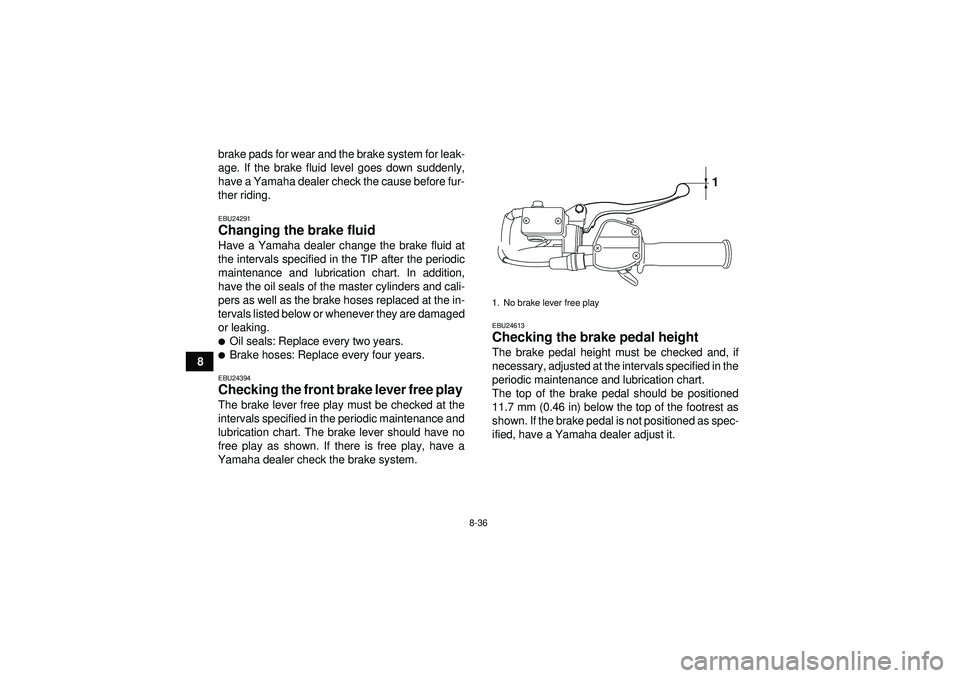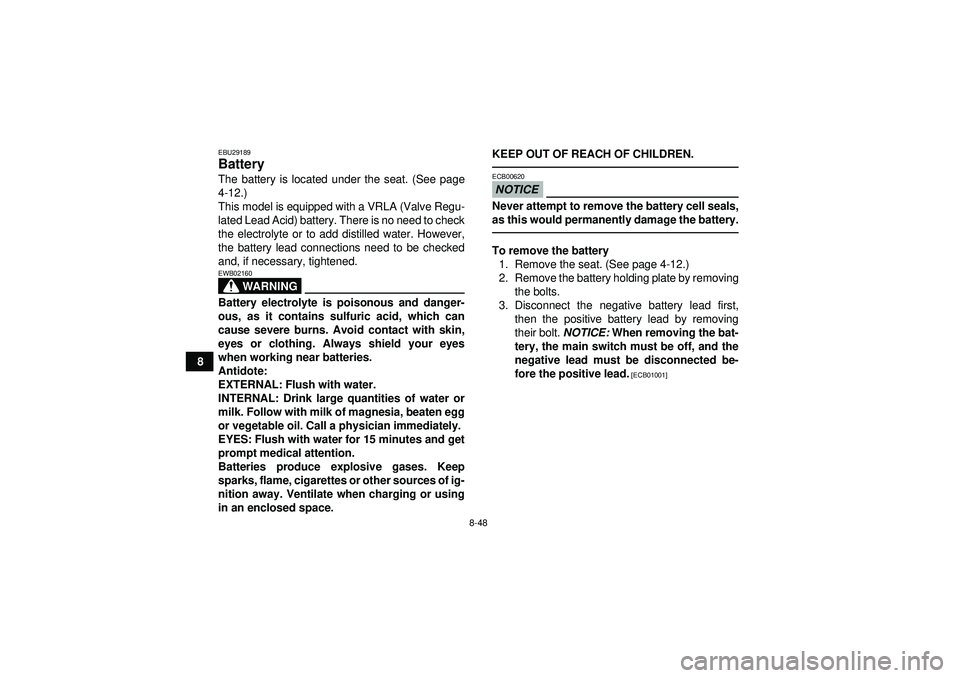Page 98 of 152
8-18
89. Check the O-rings for damage, and replace
them if necessary. 10. Install a new oil filter element and new O-
rings.
TIPMake sure that the O-rings are properly seated.11. Install the oil filter element cover by installingthe bolts, and then tighten them to the speci-
fied torque.
1. Oil filter element cover
2. Bolt
1
2
1. Oil filter element
2. O-ringTightening torque:
Oil filter element cover bolt:10 Nm (1.0 m ·kgf, 7.2 ft ·lbf)
1
2
2
U1PD60E0.book Page 18 Monday, June 13, 2011 2:57 PM
Page 100 of 152

8-20
8a higher quality than specified. In addition,
do not use oils labeled
“ENERGY CONSERV-
ING II” or higher.
�Make sure that no foreign material enters the
crankcase.15. Start the engine, and then let it idle for several
minutes while checking it for oil leakage. If oil
is leaking, immediately turn the engine off and
check for the cause.
16. Turn the engine off, and then check the oil lev- el and correct it if necessary.
17. Install the engine guard by installing the bolts, and then tighten them to the specified torque.
NOTICE: Be sure to apply LOCTITE
® to the
engine guard bolts before installing them.
[ECB00371] EBU23470
Coolant The coolant level should be checked before each
ride. In addition, the coolant must be changed at
the intervals specified in the periodic maintenance
and lubrication chart.EBU27942To check the coolant level
1. Place the ATV on a level surface.TIPThe coolant level must be checked on a cold en-
gine since the level varies with engine tempera-
ture.2. Check the coolant level in the coolant reser- voir.TIPThe coolant should be between the minimum and
maximum level marks.
Tightening torque:Engine guard bolt:7 Nm (0.7 m ·kgf, 5.1 ft ·lbf)
U1PD60E0.book Page 20 Monday, June 13, 2011 2:57 PM
Page 106 of 152
8-26
88. Wash the sponge material gently but thor-
oughly in solvent. WARNING! Always use
parts cleaning solvent to clean the sponge
material. Never use low-flash-point sol-
vents or gasoline to clean the sponge ma-
terial because the engine could catch fire
or explode.
[EWB01941]
9. Squeeze the excess solvent out of the sponge material and let it dry. NOTICE: Do not twist
the sponge material when squeezing it.
[ECB00441]
10. Check the sponge material and replace it if damaged.
11. Apply Yamaha foam air filter oil or other qual- ity foam air filter oil to the sponge material.TIPThe sponge material should be wet but not drip-
ping.12. Pull the sponge material over the air filter ele-ment frame.
13. Apply all-purpose grease to the air filter ele- ment seat.
1. Sponge material
2. Air filter element frame
1
2
U1PD60E0.book Page 26 Monday, June 13, 2011 2:57 PM
Page 115 of 152

8-35
8
5. Install the brake fluid reservoir bracket bolt.
6. Install the seat.
WARNING
EWB02720Improper maintenance can result in loss of
braking ability. Observe these precautions:
�Insufficient brake fluid may allow air to enter
the brake system, reducing braking perfor-
mance.�Clean the filler cap before removing. Use
only DOT 4 brake fluid from a sealed contain-
er.�Use only the specified brake fluid; otherwise,
the rubber seals may deteriorate, causing
leakage.�Refill with the same type of brake fluid. Add-
ing a brake fluid other than DOT 4 may result
in a harmful chemical reaction.�Be careful that water does not enter the
brake fluid reservoir when refilling. Water
will significantly lower the boiling point of
the fluid and may result in vapor lock.NOTICEECB01160Brake fluid may damage painted surfaces or
plastic parts. Always clean up spilled fluid im-
mediately.As the brake pads wear, it is normal for the brake
fluid level to gradually go down. A low brake fluid
level may indicate worn brake pads and/or brake
system leakage; therefore, be sure to check the
1. Frame
2. Projection
3. Brake fluid reservoir bracket
4. BoltSpecified brake fluid:
DOT 4
2 3
1 4
U1PD60E0.book Page 35 Monday, June 13, 2011 2:57 PM
Page 116 of 152

8-36
8brake pads for wear and the brake system for leak-
age. If the brake fluid level goes down suddenly,
have a Yamaha dealer check the cause before fur-
ther riding.
EBU24291Changing the brake fluid Have a Yamaha dealer change the brake fluid at
the intervals specified in the TIP after the periodic
maintenance and lubrication chart. In addition,
have the oil seals of the master cylinders and cali-
pers as well as the brake hoses replaced at the in-
tervals listed below or whenever they are damaged
or leaking.�Oil seals: Replace every two years.�Brake hoses: Replace every four years.EBU24394Checking the front brake lever free play The brake lever free play must be checked at the
intervals specified in the periodic maintenance and
lubrication chart. The brake lever should have no
free play as shown. If there is free play, have a
Yamaha dealer check the brake system.
EBU24613Checking the brake pedal height The brake pedal height must be checked and, if
necessary, adjusted at the intervals specified in the
periodic maintenance and lubrication chart.
The top of the brake pedal should be positioned
11.7 mm (0.46 in) below the top of the footrest as
shown. If the brake pedal is not positioned as spec-
ified, have a Yamaha dealer adjust it.1. No brake lever free play
1
U1PD60E0.book Page 36 Monday, June 13, 2011 2:57 PM
Page 123 of 152

8-43
8
EBU24882Lubricating the drive chain The drive chain must be cleaned and lubricated at
the intervals specified in the periodic maintenance
and lubrication chart, otherwise it will quickly wear
out, especially when riding in dusty or wet areas.
Service the drive chain as follows.NOTICEECB00561The drive chain must be lubricated after wash-
ing the ATV or riding in the rain or wet areas.1. Clean the drive chain with kerosene and asmall soft brush. NOTICE: To prevent dam-
aging the O-rings, do not clean the drive
chain with steam cleaners, high-pressure
washers or inappropriate solvents.
[ECB00571]
2. Wipe the drive chain dry.
3. Thoroughly lubricate the drive chain with a special O-ring chain lubricant. NOTICE: Do
not use engine oil or any other lubricants
for the drive chain, as they may contain
substances that could damage the O-
rings.
[ECB00581]
EBU24902
Checking and lubricating the cables The operation and the condition of all control ca-
bles should be checked before each ride, and the
cables and cable ends should be lubricated if nec-1. O-rings
1
1
U1PD60E0.book Page 43 Monday, June 13, 2011 2:57 PM
Page 124 of 152

8-44
8essary. If a cable is damaged or does not move
smoothly, have a Yamaha dealer check or replace
it.
WARNING
EWB02581�Inspect cables frequently and replace if dam-
aged. Corrosion can result when the cable
sheaths become damaged, and cables can
also become frayed or kinked, which could
restrict the operation of controls and lead to
an accident or injury.�Always make sure all control cables work
smoothly before you begin riding in cold
weather. If the control cables are frozen or do
not work smoothly, you could be unable to
control the ATV, which could lead to an acci-
dent or collision.
EBU24922Checking and lubricating the brake and
clutch levers The operation of the brake and clutch levers
should be checked before each ride, and the lever
pivots should be lubricated if necessary.
Brake lever
Recommended lubricant:
Yamaha Chain and Cable Lube or engine oilRecommended lubricants: Brake lever:Silicone grease
Clutch lever: Lithium-soap-based grease
U1PD60E0.book Page 44 Monday, June 13, 2011 2:57 PM
Page 128 of 152

8-48
8
EBU29189Battery The battery is located under the seat. (See page
4-12.)
This model is equipped with a VRLA (Valve Regu-
lated Lead Acid) battery. There is no need to check
the electrolyte or to add distilled water. However,
the battery lead connections need to be checked
and, if necessary, tightened.
WARNING
EWB02160Battery electrolyte is poisonous and danger-
ous, as it contains sulfuric acid, which can
cause severe burns. Avoid contact with skin,
eyes or clothing. Always shield your eyes
when working near batteries.
Antidote:
EXTERNAL: Flush with water.
INTERNAL: Drink large quantities of water or
milk. Follow with milk of magnesia, beaten egg
or vegetable oil. Call a physician immediately.
EYES: Flush with water for 15 minutes and get
prompt medical attention.
Batteries produce explosive gases. Keep
sparks, flame, cigarettes or other sources of ig-
nition away. Ventilate when charging or using
in an enclosed space.KEEP OUT OF REACH OF CHILDREN.
NOTICEECB00620Never attempt to remove the battery cell seals,
as this would permanently damage the battery.To remove the battery
1. Remove the seat. (See page 4-12.)
2. Remove the battery holding plate by removing the bolts.
3. Disconnect the negative battery lead first, then the positive battery lead by removing
their bolt. NOTICE: When removing the bat-
tery, the main switch must be off, and the
negative lead must be disconnected be-
fore the positive lead.
[ECB01001]
U1PD60E0.book Page 48 Monday, June 13, 2011 2:57 PM